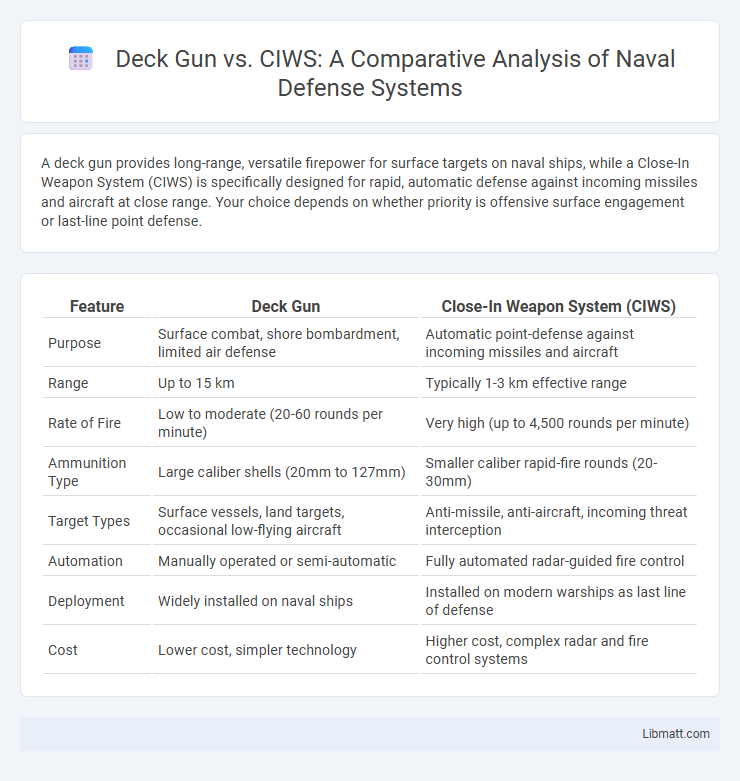A deck gun provides long-range, versatile firepower for surface targets on naval ships, while a Close-In Weapon System (CIWS) is specifically designed for rapid, automatic defense against incoming missiles and aircraft at close range. Your choice depends on whether priority is offensive surface engagement or last-line point defense.
Table of Comparison
| Feature | Deck Gun | Close-In Weapon System (CIWS) |
|---|---|---|
| Purpose | Surface combat, shore bombardment, limited air defense | Automatic point-defense against incoming missiles and aircraft |
| Range | Up to 15 km | Typically 1-3 km effective range |
| Rate of Fire | Low to moderate (20-60 rounds per minute) | Very high (up to 4,500 rounds per minute) |
| Ammunition Type | Large caliber shells (20mm to 127mm) | Smaller caliber rapid-fire rounds (20-30mm) |
| Target Types | Surface vessels, land targets, occasional low-flying aircraft | Anti-missile, anti-aircraft, incoming threat interception |
| Automation | Manually operated or semi-automatic | Fully automated radar-guided fire control |
| Deployment | Widely installed on naval ships | Installed on modern warships as last line of defense |
| Cost | Lower cost, simpler technology | Higher cost, complex radar and fire control systems |
Introduction to Deck Guns and CIWS
Deck guns serve as versatile naval artillery systems designed for surface targets, providing long-range firepower with calibers typically ranging from 20mm to 127mm. CIWS (Close-In Weapon Systems) function primarily as rapid-response defensive mechanisms against incoming missiles and aircraft, utilizing radar-guided Gatling guns or missile interceptors for accuracy and rapid firing rates. Your ship's defense strategy benefits from integrating both deck guns for offensive engagements and CIWS for close-range protection.
Historical Evolution of Naval Weaponry
Deck guns originated in the 19th century as primary naval artillery, evolving from smoothbore cannons to more accurate rifled barrels designed for ship-to-ship combat. The emergence of missile threats in the mid-20th century led to the development of Close-In Weapon Systems (CIWS), which use radar-guided rapid-fire cannons to defend against incoming anti-ship missiles and aircraft. Your understanding of naval defense highlights the transition from traditional deck guns to automated CIWS, reflecting advances in both targeting technology and the changing nature of maritime threats.
Deck Gun: Design and Key Functions
Deck guns are naval artillery weapons mounted on ship decks, designed primarily for surface combat, shore bombardment, and anti-aircraft defense. They feature rapid-firing capabilities, adjustable elevation, and various calibers to engage targets at medium to long ranges with explosive shells. Your ship's deck gun enhances offensive power and self-defense by delivering precise, sustained fire against enemy vessels, aircraft, and coastal positions.
CIWS: Overview and Core Capabilities
CIWS (Close-In Weapon System) is an automated, rapid-fire defense technology designed to detect and destroy incoming threats such as missiles, aircraft, and small boats at close range. Equipped with radar-guided targeting and high rates of fire, CIWS provides a critical last line of defense for naval ships. Your vessel's survivability increases significantly with CIWS, as it autonomously tracks and neutralizes fast-moving, high-risk targets before impact.
Firepower and Range Comparison
Deck guns offer versatile firepower with calibers ranging from small machine guns to large naval cannons, providing effective engagement at distances up to several kilometers. CIWS (Close-In Weapon Systems) specialize in rapid-fire, high-rate-of-fire defense against incoming missiles and aircraft, with shorter ranges typically under 2 km but superior tracking and automated targeting. Your choice between a deck gun and a CIWS depends on whether extended-range firepower or rapid close-in defense is prioritized for the vessel's operational needs.
Targeting and Engagement Systems
Deck guns rely on manual or basic fire-control systems with optical sights or radar guidance for targeting, making them effective against surface targets and slower aerial threats. CIWS (Close-In Weapon Systems) utilize advanced radar and infrared sensors paired with automated tracking and rapid-fire capabilities, enabling precise engagement of fast-moving missiles and aircraft at close range. Your defense strategy benefits significantly from CIWS's sophisticated targeting systems that ensure quick response times and higher accuracy against modern threats.
Defensive and Offensive Roles
Deck guns serve primarily offensive roles by engaging surface targets with direct firepower, supporting naval operations through long-range artillery strikes. CIWS (Close-In Weapon Systems) specialize in defensive roles by providing automated, rapid-response protection against incoming missiles, aircraft, and small boats at close range. Their complementary functions enhance a ship's overall combat effectiveness by balancing offensive firepower with critical point-defense capabilities.
Operational Scenarios and Effectiveness
Deck guns provide versatile offensive and defensive firepower ideal for surface engagements and short-range threats on naval vessels, excelling in scenarios requiring precise targeting of small boats or shore positions. Close-In Weapon Systems (CIWS) are highly effective automated defense mechanisms designed to detect and destroy incoming missiles and aircraft at close range, providing rapid reaction and high accuracy in missile defense operations. CIWS outperform deck guns in intercepting fast, low-flying threats during high-intensity combat scenarios, while deck guns remain valuable for multi-purpose naval gunfire support and anti-surface warfare.
Advantages and Limitations of Each System
Deck guns offer versatile, long-range firepower ideal for engaging surface targets and providing naval gunfire support, with relatively simple maintenance and lower operational costs. CIWS (Close-In Weapon Systems) provide rapid-fire, automated defense against incoming missiles and aircraft, excelling in short-range, last-line protection but with limited range and higher maintenance demands. Your choice depends on mission priorities, balancing deck gun's broader engagement capability against CIWS's specialized missile defense effectiveness.
Future Trends in Naval Defense Technologies
Deck guns continue evolving with advanced targeting systems and electromagnetic railgun prototypes, enhancing range and precision in naval defense. Close-In Weapon Systems (CIWS) are integrating AI-driven threat detection and multi-layered missile interception capabilities to address emerging unmanned aerial and missile threats. Future trends emphasize hybrid defense architectures combining kinetic and directed-energy weapons for comprehensive, rapid-response naval protection.
Deck gun vs CIWS Infographic

 libmatt.com
libmatt.com